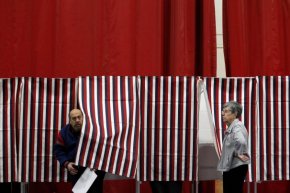Washington state Election polls
 Pretty soon, the country's top pollsters will make a subtle change that even some political junkies won't process: They will shift from reporting results of registered voters to only those most likely to vote in the 2014 election - a.k.a. "likely voters."
Pretty soon, the country's top pollsters will make a subtle change that even some political junkies won't process: They will shift from reporting results of registered voters to only those most likely to vote in the 2014 election - a.k.a. "likely voters."
For those who follow polling closely the distinction between the two is key to understanding the true state of play in a race. It's also likely to cause an apparent shift - almost certainly in the GOP's favor - that some will misinterpret as newfound momentum.
So what's the deal with the switch? And when does it happen? Below, we explain it all.
Why is the difference between registered and likely voters important?
Quite simply, not all registered voters are likely voters. The behavior and attitudes of the two groups can be slightly different - a factor that can be especially important in midterm elections in which fewer than 50 percent of eligible voters cast ballots. In order to provide accurate estimates, polls must report opinions of the people who are most likely to participate in the election. That requires expertise and judgment in sorting out poll respondents who are more or less likely to vote.
The 2010 midterm election is a good example of why the distinction makes a difference. The final Washington Post-ABC News poll before the 2010 election found Democrats leading on the generic ballot by five points among registered voters but Republicans leading by four points among likely voters. The latter estimate proved far more accurate, with Republicans receiving 51 percent of the vote across all House contests to Democrats' 44 percent.
Why do results among likely voters look better for Republicans?
This isn’t always true. The likely voter population is different in midterm versus presidential elections. Midterm elections, in which there is no national candidate and less of a focus on a broad, national campaign attracts different types of voters. Specifically, non-white and younger voters have been less apt to turn out for midterm elections. These are two key Democratic constituencies that turned out reliably in 2008 and 2012 and gave a big lift to President Obama. These two groups were less reliable for Democratic candidates in the 2010 election.
You might also like











